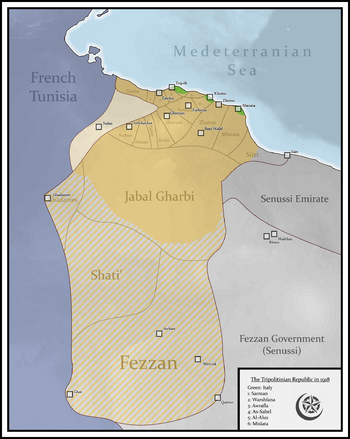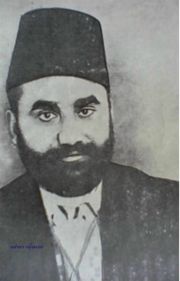الجمهورية الطرابلسية
Tripolitanian Republic | |||||||||
|---|---|---|---|---|---|---|---|---|---|
| 1918–1922 | |||||||||
 العلم | |||||||||
 الجمهورية الطرابلسية باللون البرتقالي. | |||||||||
| العاصمة | العزيزية | ||||||||
| اللغات المشتركة | Arabic , Berber | ||||||||
| الدين | Islam | ||||||||
| الحكومة | Republic (under a 4-member Supreme Council) | ||||||||
• Wali | رمضان السويحلي | ||||||||
• الوالي | سليمان الباروني | ||||||||
• Wali | أحمد المريد | ||||||||
• Wali | عبد النبي بلخير | ||||||||
| الحقبة التاريخية | Interwar period | ||||||||
• تأسست | November 16 1918 | ||||||||
• انحلت | 1922 | ||||||||
| |||||||||
الجمهورية الطرابلسية تتألف من الجزء الغربي من ليبيا تم الإتفاق على إعلانها بمدينة مسلاتة في 16 نوفمبر سنة 1918 و لم تستمر لفترة طويلة.
تبلورت فكرة تكوين الجمهورية الطرابلسية عقب هزيمة دول المحور في الحرب العالمية الأولى وتوقف الدعم التركي- الألماني للمقاومة الليبية ضد الاحتلال الإيطالي.
وقد بدأت الفكرة في مدينة مصراتة على اثر اجتماع بين الشيخ سليمان باشا الباروني والمجاهد رمضان السويحلي..
خلفية
Tripolitania had been an Ottoman possession since the 16th century, as the Tripolitania Eyalet and later Vilayet.[1] Its territory was not solely limited to Tripolitania, however, as parts of Barqa were also controlled by the Pasha of Tripoli. After Tunis and Egypt fell to the French and British respectively, Tripolitania was the last Ottoman possession in Africa. In 1912, the Kingdom of Italy launched an invasion of Tripolitania, and annexed the territory after defeating the Ottoman troops there.
The Italians did not maintain solid control of the region at first. During the Senussi Campaign of World War I, the Senussi Order led a resistance that pushed the Italian forces back to a handful of port cities. The Senussi were supported in this effort by Germany and the Ottoman Empire,[2] as well as by various local tribes and chiefdoms. It was in this context of general chaos in Northern Libya in which the Tripolitanian Republic was founded.
الاستقلال

إعلان الجمهورية في خريف 1918 was followed by a formal declaration of independence at the 1919 Paris Peace Conference.
The capital of the republic was the town of 'Aziziya, 40km south of then italian-occupied Tripoli, and its territory stretched, at its widest, from the Nafusa Mountains near the Tunisian border, to Misrata and the surrounding coast, encompassing all the hinterland between them, the only exceptions being italian-held Tripoli and Homs areas.[5]
It was governed by a tetrarchy composed of سليمان الباروني ورمضان السويحلي وعبد النبي بلخير وأحمد المريد, although each one acted autonomous from each other, as they had significant ideological differences between them.[6] This was the first formally declared republican form of government in Libya and in the whole Arab World, but it gained little support from international powers.
الانحلال وإعادة التأسيس
The Italian colonial authorities negotiated with al-Baruni and other chiefs, publishing 1 June 1919 a Colonial Statute for Tripolitania, in which the colonial administration would give native Tripolitanians rights to Italian citizenship, recognition of the Islamic Law as the Civil Law of the colony, and provided that the colony would be governed by an Italian governor advised by a 10-member council, with 8 of those members being elected.[7]
At first, the Tripolitanian leaders were satisfied with the statute officially dissolved the Republic the 12th of July, but, when Vicenzo Garioni (the colonial governor which had negotiated with the rebel leaders) was recalled to Italy in mid-August and the new governor, Vittorio Menzinger did not seem to apply the Statute, the former rebel leaders formed the National Reform Party (Hizb al-Islam al-Watani) to exert pressure on the Italians. The main leaders of the Party were 'Azzam, al-Qarqani and al-Gharyani.[8]
However, by November, the elections for the council hadn't been celebrated, and the main leaders and chiefs of Tripolitania declared and reestablished the Republic the 16th of November in Misratah, just 4 months after being dissolved, and the establishment of a governing body: the Reform Committee.[9]
In 1920, delegates from occupied and free zones met in Aziza, on a National Congress. Claiming to represent the "Tripolitanian Nation," they called for the withdrawal of the Italian forces.
The next appointed governors, Luigi Mercatelli and Giuseppe Volpi turned to the military power to subjugate the region. The division between insurgents was getting bigger, and, after the death of al-Suwaylih in August 1920 by political opponents, the rebels started to fracture and the Republic, still in its conflict with the Italians, fell into civil war.
By early 1922, the Tripolitanians were desperate and met with Senussi delegates, offering Idris (the leader of the Senussi and Emir of Cyrenaica) the right to be the Emir of Tripolitania. Idris' acceptance, as the nationalists understood, would draw sharp Italian disapproval and be the signal for the resumption of open warfare. War with Italy, in any event, appeared likely sooner or later. For several months, Idris pondered the nationalist appeal. For whatever reason – perhaps to further the cause of total independence or perhaps out of a sense of religious obligation to resist the infidel – Idris accepted the amirate of all Libya in November and then, to avoid capture by the Italians, fled to Egypt, where he continued to guide the Sanusi order.[10]
By 1923, Italian control was effective in the territories of the Republic, which ceased to exist, but still was confined to the Tripolitanian and outer Cyrenaican areas, the rest of the country, still in the hands of the Senussi-led rebels, had yet to be conquered and pacified.
أجهزة الدولة
مجلس الرئاسة
ويتكون من اربعة رؤساء وهم :
مجلس الشورى
ويتكون من اربعة وعشروين عضواوله رئيسيين
- الشيخ سوف المحمودي رئيسا اولا.
- الشيخ يحيي الباروني رئيسا ثانيا.
وعضوية كل من : الشيخ عبد الصمد النعاس ، عضوا ، من ترهونة. الحاج مفتاح التريكي ، عضوا ، من مسلاتة. الشيخ على بن رحاب ، عضوا ، من قماطة. الحاج محمد بن خليفة ، عضوا ، من الساحل. عبد السلام الجدايمي ، عضوا ، من زليتن. الحاج علي المنقوش ، عضوا ، من مصراتة. محمد المنتصر ، عضوا ، عن سرت. مفتاح التايب ، عضوا ، من ورفلة. السيد محمد بن بشير ، عضوا ، أولاد أبي سيف. عبد الرحمن بركان ، عضوا ، من مرزق ـ فزان. محمد بن أحمد الفايدي ، عضوا من الشاطيء. الشيخ الحبيب عز الدين ، عضوا ، من غدامس. إبراهيم أبي الأحباس ، عضوا ، من الجبل. الحاج محمد فكيني ، عضوا ، من الرجبان. الشيخ أحمد البدوي ، عضوا ، من الزنتان. سالم البرشوشي ، عضوا ، من ككلة. الشيخ شطيبة ، عضوا ، غريان. علي بن تنتوش ، عضوا ، من ورشفانة. عبد الرحمن شلابي ، عضوا ، من الزاوية. علي شالابي ، عضوا ، النواحي الأربعة. عبيدة المحجوبي ، عضوا ، عن صرمان والعجيلات.
المجلس الشرعي
( مجلس العلماء) يتكون من اربعة علماء: الشيخ عمر الميساوي ، والشيخ الزروق بورخيص ، والشيخ محمد الإمام ، والشيخ مختار الشكشوكي.
يمين الولاء والإخلاص للجمهورية
قبل الانصراف من المسجد أقسم الحاضرون جميعا يمين الولاء والإخلاص للجمهورية . وتوكيدا لليمين أحضروا مصحفا وكل من اراد اليمين وضع يده عليه . وهذا نص اليمين : (( أقسم بالله العظيم قابضا بيدي على هذا القرآن الكريم أن أجعل نفسي ومالي فداء لوطني وحكومتي الجمهورية الطرابلسية ، وأن أكون لعدوها عدوا ولصديقها صديقا ، ولقانونها الشرعي مطيعا ))وقد تم عقد الإجتماع وحلف اليمين بجامع المجابرة بمدينة مسلاتة.
رد فعل الشعب
كان للجمهورية الطرابلسية أحسن الأثر في نفوس الشعب الطرابلسي ، ونشاط سرى في جميع مرافق الحياة وأحس الناس بتطور غريب في حياتهم السياسية اعتقدوا أن مصدره هذه الجمهورية التي رأوا فيها فتحا مبينا ، وثمرة من ثمرات جهادهم الموفق . ولم يكن سكان المدن في طرابلس أقل فرحا بهذه الجمهورية من إخوانهم المجاهدين ، فقد كان شعور الطرابلسيين متجها إلى ناحية واحدة هي التغلب على الطليان ، وكانت الجمهورية مثالا بارزا في التعبير عن هذا المعنى ، فكانت في محل الإجلال والتعظيم من نفس كل طرابلسي .
وقد رأى أعضاء الجمهورية أن الوضع الحربي يقضي بأن يقيم كل عضو من أعضاء الجمهورية في منطقة نفوذه يصرف أعمالها كيفما يرى متحملا تبعة أعماله ، فأقام رمضان بك في مسلاتة ، وأحمد بك المريض في ترهونة ، وسليمان باشا الباروني في العزيزية والزاوية ، وعبد النبي بن خير في أرفلة . وكان من بين قرارات الجمهورية إسناد قيادة المجاهدين العامة غلى عبد القادر الغناي بدلا من إسحاق باشا ، وأن تكون الزاوية مقر هذه القيادة
المصادر
- تاريخ الفتح العربي في ليبيا ، للزاوي .
للاستزادة
- Anderson, Lisa (1982). Joffe, George; MacLachlan, Keith (eds.). "The Tripoli Republic". Social and Economic Development of Libya. Wisbeck: Menas Press. ISBN 9780906559109.
المراجع
- ^ Almanach de Gotha: annuaire généalogique, diplomatique et statistique. J. Perthes. 1867. pp. 827–829. Retrieved 2013-06-01.
- ^ Zürcher, Erik-Jan (1867). Jihad and Islam in World War I. Leiden University Press. doi:10.26530/OAPEN_605452. ISBN 9789087282509. Retrieved 2022-09-01.
- ^ http://www.hubert-herald.nl/LibyaTripoli.htm
- ^ http://www.hubert-herald.nl/LibyaTripoli.htm
- ^ Libya between History and Revolution: Resilience, New Opportunities and Challenges for the Berbers. UNIVERSITÀ DEGLI STUDI DI NAPOLI “L’ORIENTALE”. 2020. pp. 67–78.
- ^ Libya between History and Revolution: Resilience, New Opportunities and Challenges for the Berbers. UNIVERSITÀ DEGLI STUDI DI NAPOLI “L’ORIENTALE”. 2020. pp. 67–78.
- ^ A History of the Maghrib in the Islamic Period. Cambridge University Press. 1987. p. 395. ISBN 9780521337670. Retrieved 2022-01-09.
- ^ A History of the Maghrib in the Islamic Period. Cambridge University Press. 1987. p. 395. ISBN 9780521337670. Retrieved 2022-01-09.
- ^ Libya - Italian Rule and Arab Resistance, consulted 09-02-2022
- ^ Libya - Italian Rule and Arab Resistance, consulted 09-02-2022
- Short description is different from Wikidata
- Articles containing explicitly cited عربية-language text
- Libya articles missing geocoordinate data
- All articles needing coordinates
- 1918 establishments in Africa
- Former countries in Africa
- Italian Libya
- History of Tripolitania
- Former republics
- Former countries of the interwar period
- States and territories established in 1918
- States and territories disestablished in 1922
- تاريخ ليبيا

